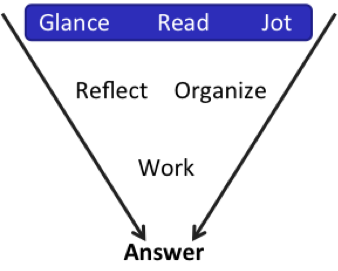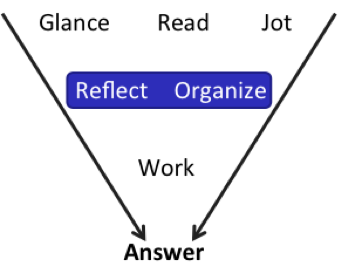-
Target Test Prep 20% Off Flash Sale is on! Code: FLASH20
Redeem
How to Become a Great GMAT Guesser - Part 1
 Youve probably figured out by now that, sometimes, youre just going to have to guess on the GMAT. If youve got 5 seconds to get something in before the test is over, all you can do is pick your favorite letter and get it in before the thing ends. (Or maybe youve got 30 seconds to get answers in for 6 questions. :( )
Youve probably figured out by now that, sometimes, youre just going to have to guess on the GMAT. If youve got 5 seconds to get something in before the test is over, all you can do is pick your favorite letter and get it in before the thing ends. (Or maybe youve got 30 seconds to get answers in for 6 questions. :( )
Ideally, though, youre aware enough of your time that you can choose to sacrifice certain questions along the way: those that look especially annoying or are extra-hard for you. When you do this, you often wont have any idea what to guessagain, just pick your favorite letter and move on.
But! There are certain things you can learn that will allow you to narrow down to 2 or 3 choices in just 20 to 30 seconds. Given a choice between that and spending 2(+) minutes getting the exact answer when youre already behind on time its a pretty smart call to guess and move on.
Try out the problem below from the free GMATPrep exams and then well talk about how you can narrow this one down to 2 answers in almost no time at all.
*Susan drove at an average speed of 30 miles per hour for the first 30 miles of a trip and then at an average speed of 60 miles per hour for the remaining 30 miles of the trip. If she made no stops during the trip, what was Susans average speed, in miles per hour, for the entire trip?(A) 35
(B) 40
(C) 45
(D) 50
(E) 55
What did you get? And what did you think of the math? How long did it take?
Now, lets say that you are enough behind on time that you know you need to bail on at least one question. And lets say that either this type of problem is a weakness for you or you recognize that theres a decent amount of calculation involved in finding this number. Its not an inherently fast problem.
You realize all of this when you glance at the problem, so you decide that this one has to be a candidate for a guess.
But wait!
Theres a general rule / guideline regarding average speed that we can use to make a fast guess. (And if you havent learned it before, youre about to now!)
Here it is:
When averaging two speeds for a trip taken over the same distance,
the average is always LESS THAN the straight average of the two speeds.
First, lets check the requirement that the two mini-trips need to be over the same distance. Are they? Yes, she drove 30 miles per hour for 30 miles and 60 miles per hour for another 30 miles.
Next, here are the two speeds in this problem: 30 miles per hour and 60 miles per hour. Whats the straight average of these speeds?
Its half-way between: 45 miles per hour.
And now follow the rule: the actual average speed will always be less than the straight average speed. The answer to this problem must be less than 45 miles per hour.
Boom! Eliminate (C), (D), and (E). Guess between (A) and (B). Done. If you know this rule and when to apply it, you can be guessing and moving on within about 20 seconds of this question popping up on the screen.
Do you want to know how to do the real math? All right, lets do it. :)
Jot down the info as you read.
The total distance is the easier part: she drove 30 + 30 = 60 miles.
Total time is a little more annoying. How long did it take her to go 30 miles when driving 30 miles per hour? You might think about this logically ("If I were driving 30 mph, and I needed to drive 30 miles, that'd take me an hour) or you might straight-up calculate it:
RT = D
(30)(T) = 30
T = 1
It takes her an hour to go 30 miles at a speed of 30 mph. And when she drives twice as fast, 60 mph, it takes her half as long to drive the same distance: 0.5 hours.
Now, you might be able to see why the average speed is not a straight average of the two speeds. She spends a whole hour driving 30 miles an hour, but she spends only half an hour driving 60 miles an hour.
In other words, this is a weighted average: she spends more time driving at the slower speed. And, since she spends more time at the slower speed, the slower speed weighs more when calculating the average speed. If the two distances are the same, then it will always be true that you spend more time driving at the slower speed, no matter the speeds involved. Thats why the average speed is always slower than the straight average of the two speeds.
Okay, back to the math. Total distance is 60 miles. Total time is 1.5 hours.
The correct answer is (B).
One more thing. Are you really into this math? Want to learn something else neat? Here's a shortcut to the real math. (Caveat: this is only neat if you totally get weighted averages and you feel pretty comfortable with mental math!)
You do still have to determine how long the two trips take. But when you do, you can use the fact that the weighted average is tied to the ratio of the two times to shortcut the rest of the math. (Thats maybe not as important on this problem, because the math isnt terrible. But you can imagine that they might give you much harder numbers.)
The slower trip (at 30 mph) took an hour and the faster trip (at 60 mph) took half an hour, so the ratio of time for the slower trip to time for the faster trip is 1:0.5 or 2:1. The slower trip, therefore, is weighted twice as heavily as the faster trip.
Now, the two speeds were 30 mph and 60 mph. The weighted average has to fall somewhere between these two numbers. Calculate the difference between the two: 60 minus 30 is 30.
The slower trip gets allocated 2 parts of this difference to every 1 part that is allocated to the faster trip. So the slower trip accounts for 20/30 parts and the faster trip accounts for 10/30 parts. The weighted average, therefore, lies 10 parts from one end of the 30-to-60 continuum and 20 parts from the other end of the continuum.
But from which end do we count? The slower trip is weighted more heavily, so the average has to be closer to the 30 end of the continuum. Add the smaller number, 10, to the slower trip speed (30 mph) to get 40 mph: the answer. (Alternatively, you can subtract 20 from the faster speed, 60. I find adding easier than subtracting, so I do the math from that end of the two speeds.)
Note: that last step is a potential source of a careless error. People want to put the 20 parts next to the 30, since the 30 mph "goes with" 20 parts. If you do that, though, look what happens to the weighted average: it becomes 50. That doesn't make logical sense; the 30 mph end is supposed to be weighted more heavily. Keep in mind which end is supposed to be weighted more heavily. The average needs to be closer to that end.
Join us next week for the second installment of this serieswe'll tackle a Data Sufficiency problem.
Key Takeaways to Become a Great Guesser
(1) Dont just study how to correctly answer problems using real math. Study how to get rid of 1, 2, 3, and sometimes all 4 wrong answers! Business is not all about getting to the right answer every time; often, there's not even an objectively "right" answer. Its about using your resources in the most effective way across everything that you need to get done.
(2) Theres more than one good reason to guess! You may decide to guess because you realize that you can narrow down to two answers super quickly (as on this problem) but the extra time needed to find the one right answer is not worth the investment.
* GMATPrep questions courtesy of the Graduate Management Admissions Council. Usage of this question does not imply endorsement by GMAC.
Recent Articles
Archive
- April 2024
- March 2024
- February 2024
- January 2024
- December 2023
- November 2023
- October 2023
- September 2023
- July 2023
- June 2023
- May 2023
- April 2023
- March 2023
- February 2023
- January 2023
- December 2022
- November 2022
- October 2022
- September 2022
- August 2022
- July 2022
- June 2022
- May 2022
- April 2022
- March 2022
- February 2022
- January 2022
- December 2021
- November 2021
- October 2021
- September 2021
- August 2021
- July 2021
- June 2021
- May 2021
- April 2021
- March 2021
- February 2021
- January 2021
- December 2020
- November 2020
- October 2020
- September 2020
- August 2020
- July 2020
- June 2020
- May 2020
- April 2020
- March 2020
- February 2020
- January 2020
- December 2019
- November 2019
- October 2019
- September 2019
- August 2019
- July 2019
- June 2019
- May 2019
- April 2019
- March 2019
- February 2019
- January 2019
- December 2018
- November 2018
- October 2018
- September 2018
- August 2018
- July 2018
- June 2018
- May 2018
- April 2018
- March 2018
- February 2018
- January 2018
- December 2017
- November 2017
- October 2017
- September 2017
- August 2017
- July 2017
- June 2017
- May 2017
- April 2017
- March 2017
- February 2017
- January 2017
- December 2016
- November 2016
- October 2016
- September 2016
- August 2016
- July 2016
- June 2016
- May 2016
- April 2016
- March 2016
- February 2016
- January 2016
- December 2015
- November 2015
- October 2015
- September 2015
- August 2015
- July 2015
- June 2015
- May 2015
- April 2015
- March 2015
- February 2015
- January 2015
- December 2014
- November 2014
- October 2014
- September 2014
- August 2014
- July 2014
- June 2014
- May 2014
- April 2014
- March 2014
- February 2014
- January 2014
- December 2013
- November 2013
- October 2013
- September 2013
- August 2013
- July 2013
- June 2013
- May 2013
- April 2013
- March 2013
- February 2013
- January 2013
- December 2012
- November 2012
- October 2012
- September 2012
- August 2012
- July 2012
- June 2012
- May 2012
- April 2012
- March 2012
- February 2012
- January 2012
- December 2011
- November 2011
- October 2011
- September 2011
- August 2011
- July 2011
- June 2011
- May 2011
- April 2011
- March 2011
- February 2011
- January 2011
- December 2010
- November 2010
- October 2010
- September 2010
- August 2010
- July 2010
- June 2010
- May 2010
- April 2010
- March 2010
- February 2010
- January 2010
- December 2009
- November 2009
- October 2009
- September 2009
- August 2009

